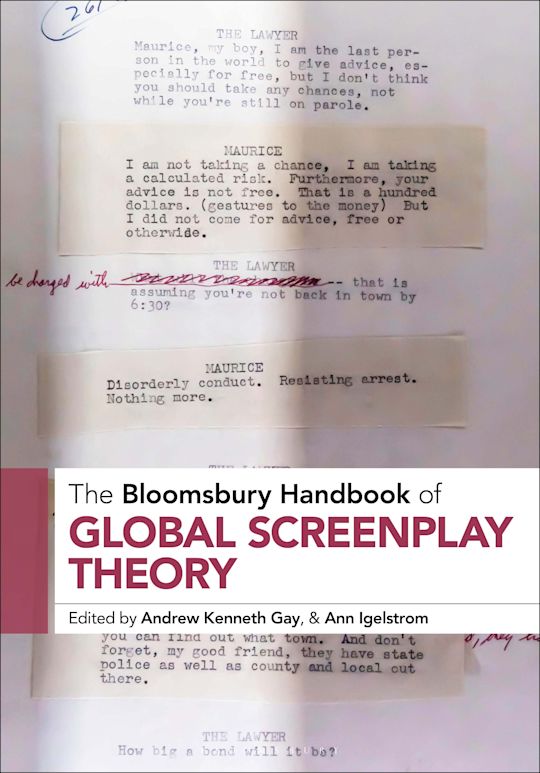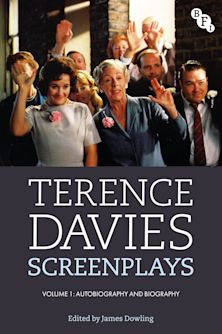The Bloomsbury Handbook of Global Screenplay Theory
The Bloomsbury Handbook of Global Screenplay Theory
Payment for this pre-order will be taken when the item becomes available
Description
The Bloomsbury Handbook of Global Screenplay Theory offers a comprehensive introduction and overview of screenplay theory as applied in the analysis of numerous screenplays from an international, multi-author perspective, including both leading and emerging scholars in the field. Each section includes 6-8 case studies of theory applied in the analysis of a landmark screenplay.
The sections are divided thematically, with sections addressing the Screenplay as Narration and Focalisation, the Screenplay as Narrative Structure, the Screenplay as Cinematic Language and the Screenplay as Creative Practice. With both theorists and practitioners contributing to this volume, the focus is on the actual screenplay as opposed to analysis of the final film. The essays contribute to a new era in screenplay theory, providing valuable insights not only into the particular screenplays under analysis but also into the range of ways in which such analysis can be approached, representing a wide range of theoretical perspectives.
Table of Contents
List of Tables
Acknowledgements
Editors and Contributors
Introduction: In Search of Screenplay Theory
Andrew Kenneth Gay (Southern Oregon University, USA) and Ann Igelstrom (Independent Scholar, UK)
Part I: The Screenplay as Narration and Focalisation
1. 'THE CAMERA IS JEAN-DOMINIQUE BAUBY': Narration & Focalisation in Three Texts of The Diving Bell and the Butterfly (1997/n.d./2007)
Andrew Kenneth Gay (Southern Oregon University, USA)
2. The Hole at the Centre of the Donut: A Question of Focalisation and Character Perspective in Knives Out (2019)
Ann Igelstrom (Independent Scholar, UK)
3. Writing the Viewer: Narration and Perspective in a Cinematic Virtual Reality Screenplay
Kath Dooley (Adelaide University, Australia)
4. Making Sense of Character Perspective in Languages of the 'Big Print': The Case of a Hand Losing Her Body in J'ai perdu mon corps / I Lost My Body (2019)
Carina Böhm (Independent Scholar, Australia) and Craig Batty (Adelaide University, Australia)
5. Past and Present, Old and New (1929): On Tense, Time, and Narrators in Screenwriting
Alexandra Ksenofontova (Independent Scholar, Germany)
6. Look At Me: The Child's Gaze as a Culturally Informed Narrative Device in the Danish Screenplay En du elsker / Someone You Love (2014)
Cath Moore (University of Melbourne, Australia)
Part II: The Screenplay as Narrative Structure
7. Imposing New Hollywood Structure on the Remake of 3:10 to Yuma (2007)
Mads Larsen (Norwegian University of Science and Technology, Norway)
8. Community-Centered Screenwriting: the Actualization of Narrative Sovereignty in Sterlin Harjo and Taika Waititi's Reservation Dogs (2021-2023)
Jess King (DePaul University, USA) and Michelle Hurtubise (Temple University, USA)
9. Narrative Structure in Mari Okada's Maquia: When the Promised Flower Blooms, Japan (2018)
Maxine Gee (Bournemouth University, UK)
10. Narrative Structure in the Iranian Screenplay: An Analysis of Asghar Farhadi's The Salesman (2016)
Chris Neilan (Manchester Metropolitan University, UK)
11. Time, Narrative and Boyhood (2014)
Carolina Amaral (Pontifícia Universidade Católica do Rio de Janeiro, Brazil)
12. Time is Not Relative – A Modern and Postmodern Approach to Time in Kubrick's The Shining (1980)
Kerstin Stutterheim (Edinburgh Napier University, UK)
13. Is It Or Isn't It? Narrative Ambiguity and Queerness in Barbie (2023)
Tracy Mathewson (University College London, UK)
Part III: The Screenplay as Cinematic Language
14. Visual Dramaturgy – from Caligari (1920) to Shutter Island (2010)
Kerstin Stutterheim (Edinburgh Napier University, UK)
15. Cinema and the Camera-Eye in Alan Sharp's Screenplay-Novel Hybrid Picture Yourself (n.d.)
River Seager (Independent Scholar, UK)
16. Apropos of Editing and Camera Cues: A Comparative Analysis of the Screenplay Texts for Federico Fellini's Le notti di Cabiria / Nights of Cabiria (1957)
Claudia Romanelli (The University of Alabama, USA)
17. A Boy and His Watermelons: Mise-En-Scene in Sweet Country (2017)
Glenda Hambly (Monash University, Australia)
18. Sound Design and Music Proposals in Lucrecia Martel's Screenplay for The Swamp (2001)
Iana Cossoy Paro (EICTV International Film School, Cuba)
19. Writing in Waltz Time: Walter Reisch's Musical Writing in Two Hearts in Waltz Time (1930)
Claus Tieber (University of Vienna, Austria)
Part IV: The Screenplay as Creative Practice
20. 'Such a foreign presence in Hertfordshire': Black Georgian Women Coming into Representation in Misan Sagay's Belle (2009/2012)
Claudia Sternberg (University of Leeds, UK)
21. Characterization, Dialogue, and Performance in Lawrence Kasdan's Screenplay for Raiders of the Lost Ark (1981)
Brett Davies (Meiji University, Japan)
22. Maryam's Windows and Marziyeh's Screens – The Self-fiction at the Processes, Poetics and Authorships of This is not a film (2011) and 3 Faces (2018), by Jafar Panahi
Márcio Andrade (Independent Scholar, Brazil)
23. Dorothy Parker: The Creative Genius Behind the Film Franchise A Star Is Born
Rosanne Welch (Stephens College, US)
24. Narrative Strategies in Biopics Based on Scant Historical Evidence: The Return of Martin Guerre (1982)
Indranil Chakravarty (Independent Scholar, India)
25. Exploring Characterization and Theme in the Screenwriting Process: The Case of Gladiator (2000)
Carmen Sofia Brenes (Universidad Gabriela Mistral, Chile)
26. A Few Good Men (1992): When Adaptation Captures The Essence Of The Original
Paulo Braga (Università Cattolica del Sacro Cuore, Italy)
27. An Exemplary Adaptation: Sense And Sensibility (1995)
Armando Fumagalli (Università Cattolica del Sacro Cuore, Italy)
Index
Product details

| Published | Apr 30 2026 |
|---|---|
| Format | Ebook (Epub & Mobi) |
| Edition | 1st |
| Extent | 448 |
| ISBN | 9781501394072 |
| Imprint | Bloomsbury Academic |
| Illustrations | 22 bw illus |
| Series | Bloomsbury Handbooks |
| Publisher | Bloomsbury Publishing |


































